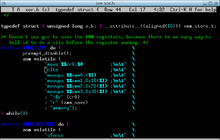 Joe 3.5, editing a C header file Joe 3.5, editing a C header file | |
| Original author(s) | Joseph H. Allen |
|---|---|
| Developer(s) | Joseph H. Allen, Marek 'Marx' Grac and others |
| Initial release | joe0.0.0 ca. August 22, 1991; 33 years ago (1991-08-22) |
| Written in | C |
| Operating system | Unix-like, DOS, Win32 |
| Platform | Cross-platform |
| Size | ≈0.45 MiB (macOS/x86) |
| Available in | English, German, French, Russian, Ukrainian |
| Type | Text editor |
| License | GPL version 1 (or later) |
| Website | joe-editor |
JOE or Joe's Own Editor is an ncurses-based text editor for Unix systems, available under the GPL. It is designed to be easy to use.
JOE is available for most major Linux distributions, open-source BSD systems and Apple's macOS via package managers such as Homebrew.
Description of features

JOE includes an integrated help system and a reminder of how to get help is always on the screen. The key sequences in JOE are similar to those of WordStar and Turbo C: many are combinations of the Control key and another key, or combinations of Ctrl+K and another key, or combinations of the Escape key and another key. Numerous settings are also available through Ctrl+T. The program is generally customizable through an extensive configuration file, and it supports color syntax highlighting for numerous popular file formats, a feature that is also configurable.
JOE installs hard links and a set of rc files that configure JOE to emulate Emacs keybindings (when invoked as jmacs), Pico (when invoked as jpico), or WordStar (when invoked as jstar). There is also a variant called "rjoe", which is restricted in that it allows one to edit only the files specified on the command line (which can be useful to enforce the principle of least privilege).
While the user interface of the editor is reminiscent of DOS editors, it also includes the typical Unix editor features such as internal command history, tab completion in file selection menus, regular expression search system and the ability to filter (pipe) arbitrary blocks of text through any external command.
History
JOE was among the default editors in the early popular Linux distributions, which gave it some prominence and helped build a user base. It continues to be included as an option in Linux distributions, sometimes in the critical role as a "rescue mode" editor.
After version 2.8 was released by Joseph Allen in 1995, the development cycle had halted for several years. The development was taken over by a new group of enthusiasts in 2001, led by Marek Grac, who released 2.9 and several later versions, introducing a standardized build system and fixing many bugs. Allen returned to the project in 2004 and released version 3.0, which introduced syntax highlighting and support for UTF-8.
The Joe of JOE is not the same Joe as the Joe of JWM.
See also
- Feature comparison of text editors
- Limited performance comparison of text editors
- List of text editors
- Nano
- ne
- WordStar diamond
References
- "J (Joe's Editor) New Release". google.ch. Archived from the original on 2022-03-23. Retrieved 2009-08-04.
- Danen, Vincent (August 2008). "Customize the Joe text editor". ZDNet White papers. Archived from the original on 2011-07-18. Retrieved 2009-09-25.
- Halliwell, Andrew (June 2001). "Joe Cool: Using the text editor Joe" (PDF). Linux Magazine. Vol. 3, no. 6. pp. 64–65. Archived from the original (PDF) on 2011-09-28. Retrieved 2009-09-26.
- "Ubuntu – Package Search Results -- joe". ubuntu.com.
- "Debian -- Package Search Results -- joe". debian.org.
- "RPM resource joe". rpmfind.net.
- ^ Jang, Michael (2007). "Basic Linux Knowledge". RHCE Linux Study Guide (4th ed.). McGraw-Hill Professional. pp. 8, 358–359. ISBN 9780072264548. Retrieved 2009-09-27.
Popular text editors for Linux configuration files include joe If you have to rescue an RHEL5 system, you'll have access to these editors when booting your system from RHEL5 rescue media. If you boot in rescue mode and try to start emacs or pico, that starts the joe editor instead.
- Fedora joe package
- "software.opensuse.org: Search". opensuse.org.
- "[ports] Index of /head/editors/joe". freebsd.org.
- "pkgsrc.se - The NetBSD package collection". pkgsrc.se.
- "OpenPorts.se - The OpenBSD package collection". openports.se. Archived from the original on 2021-04-26. Retrieved 2009-09-27.
- SLS 1.03 archive Archived 2005-01-25 at the Wayback Machine (originally released in 1993) indicates that joe was shipped as a "recommended" package on the third installation diskette of SLS
- Niels Horn's blog: Older Slackware versions states that joe was available in Slackware 1.01 (released in 1993). Slackware 1.1.2 archive (originally released in 1994) indicates that joe was shipped on the fourth diskette named AP2 (section "Various applications that do not need X")
- S.u.S.E. Linux pre-1.0 early beta (from August 1995) included joe.
- Editors section of Debian 0.93R6 (originally released in November 1995) included joe and seven other editors.
- "Popularity Contest Statistics -- Debian Quality Assurance". debian.org.
- Ubuntu popularity-contest statistics including joe
- "Joe's Own Editor - History". sourceforge.net.
Further reading
- JOE man page
- Schroder, Carla (2004-12-01). "Editing Text Files with JOE and Vim". Linux Cookbook (1st ed.). O'Reilly Media, Inc. pp. 68–77. ISBN 0-596-00640-3. Retrieved 2009-09-26.